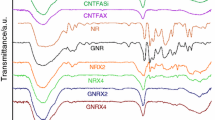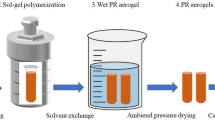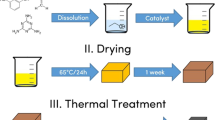Abstract
A novel phenolic resin/silica hybrid ceramer fabricated via the sol-gel method was prepared. Hybrid systems with different inorganic contents were used as the matrix precursors to fabricate the silica containing carbon/carbon composites. Isothermal oxidation tests at temperatures ranging between 650°C and 750°C were employed to investigate how the oxidation resistance of the derived carbon/carbon composites is improved. Furthermore, the isothermal oxidation test results between 550°C and 615°C were used to calculate the activation energy of oxidation. Experimental results demonstrate that the silica containing carbon/carbon composites have a better oxidation resistance than those derived from pure phenolic resins. Meanwhile, morphological observations indicate that the oxidation of carbon fibers is retarded in the phenolic resin/silica hybrid derived carbon/carbon composites.
Similar content being viewed by others
References
J. Y. Wen and G. L. Wilkes, Chem.Mater. 8 (1996) 1667.
G. L. Wilkes, B. Orler and H. H. Huang, Polym.Bull. 14 (1985) 557.
H. Schmidt, J.Non-crystal.Solids 73 (1985) 681.
A. Kioul and L. Mascia, ibid. 175 (1994) 169.
L. Mascia, Z. Zhang and S. J. Shaw, Composites Part A 27 (1996) 1211.
F. Surivet, T. M. Lam, J. P. Pascault and C. Mai, Macromol. 25 (1992) 5742.
K. Haraguchi, Y. Usami and Y. Ono, J.Mater.Sci. 33 (1998) 3337.
W. C. Chang, N. H. Tai and C. C. M. Ma, ibid. 30 (1995) 1225.
C. C. M. Ma, N. H. Tai, W. C. Chang and Y. P. Tsai, Carbon 34 (1996) 1175.
J. R. Strife and J. E. Sheehan, Am.Ceram.Soc.Bull. 67 (1988) 369.
W. C. Chang, C. C. M. Ma, H. T. Chao and N. H. Tai, J.Mater.Sci. 37 (1996) 3899.
D. W. McKee, Carbon 26 (1988) 659.
D. W. McKee, C. L. Spiro and E. J. Lamby, ibid. 22 (1984) 285.
J. K. Mun, C. O. Park, B. I. Yoon, K. S. Kim and H. J. Joo, J.Mater.Sci. 30 (1995) 1529.
J. M. Lin, C. C. M. Ma, N. H. Tai, W. C. Chang and C. C. Tsai, Polym.Comp. 21 (2000) 305.
H. W. Chang and S. K. Rhee, Carbon 16 (1978) 17.
Author information
Authors and Affiliations
Corresponding author
Rights and permissions
About this article
Cite this article
Lin, JM., Ma, CC.M. & Chang, WC. Carbon/carbon composites derived from phenolic resin/silica hybrid ceramers Part I Oxidation resistance and morphological properties. Journal of Materials Science 36, 4259–4266 (2001). https://doi.org/10.1023/A:1017945711517
Issue Date:
DOI: https://doi.org/10.1023/A:1017945711517




